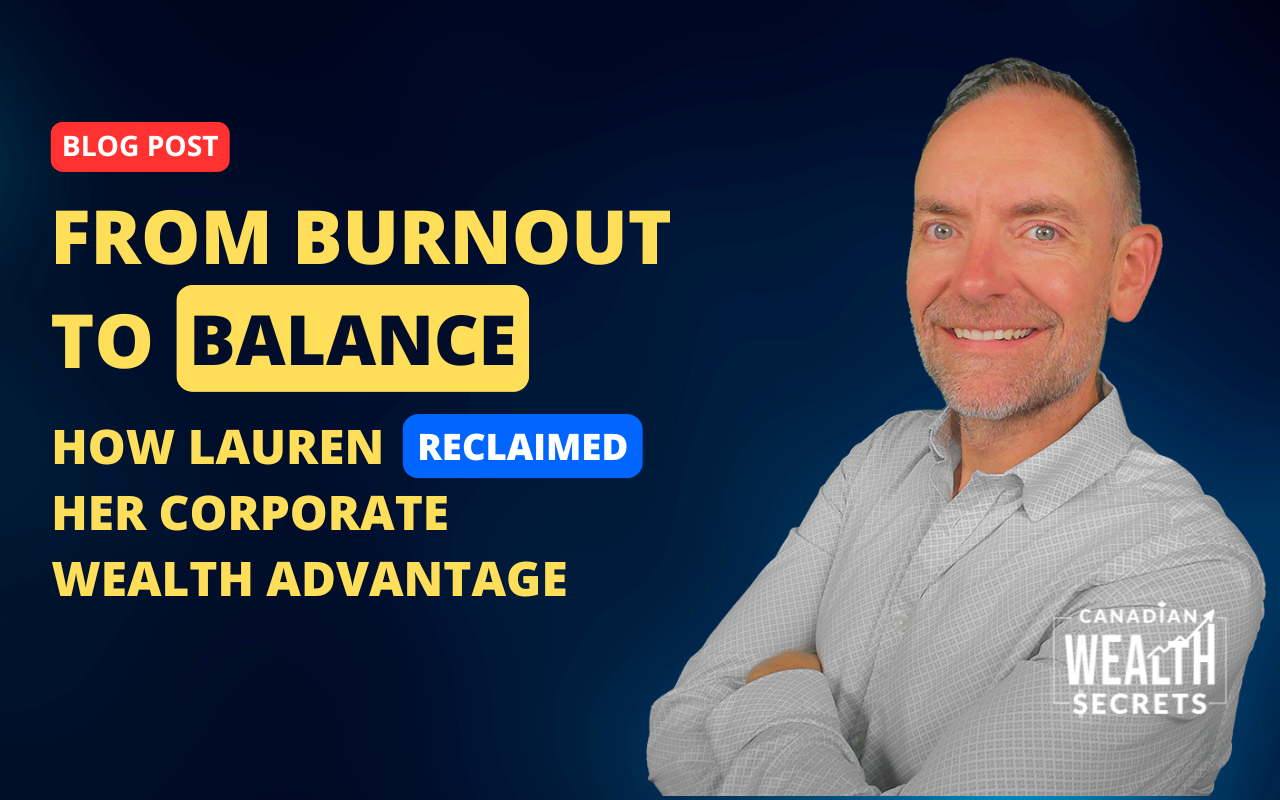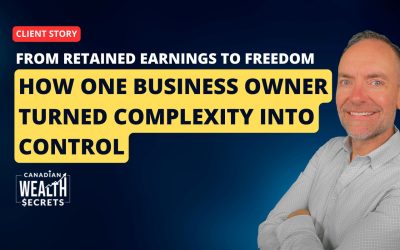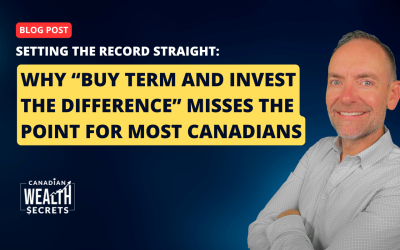For many Canadian entrepreneurs, running a business is a full-contact sport. You wear every hat, juggle every challenge, and when the dust settles, you’re just trying to make sure there’s money in the bank to support your family, your future—and maybe a well-earned vacation or two.
But for Lauren, a successful business owner and single mom of two, that effort to keep everything running smoothly came with an unintended cost: she was draining the power of her corporation without realizing it.
In this post, we’re sharing Lauren’s journey—a real-world example of how understanding tax strategy, corporate wealth management, and convertible term insurance in Canada helped her pivot from overdrawn and overwhelmed to optimized and in control.
The Wake-Up Call: A Mortgage Payment That Sparked a Wealth Shift
Lauren had always been a responsible earner and saver. Her personal income was consistently around $300,000. She was paying down her $1.4M mortgage on a $1.8M home. Her kids were in private school. She even had $300,000 invested personally.
But when she made an $80,000 lump sum mortgage payment—out of habit, not strategy—she realized something was off. “Why am I paying all this tax to take money out of my company,” she asked herself, “just to save a little interest on my mortgage?”
That’s when she stumbled across our podcast. And within a few episodes, she realized something powerful: she wasn’t using her corporation the way it was designed to be used.
Stage 1: Setting a Clear Vision
The first stage in our four-part wealth system is defining your financial destination. For Lauren, that vision was clear:
“I want $100,000 in annual passive income within 7–10 years so I can live comfortably and support my kids.”
That clarity helped guide every other decision. Instead of letting habits dictate her finances, she began to lead with intention.
Stage 2: Building Her Corporate Wealth Reservoir
Lauren’s biggest breakthrough came when she recognized the value of corporate tax deferral. Instead of pulling out $200K–300K per year and paying top personal tax rates, she now aims to draw only what she needs: around $120K–150K per year.
Why it matters:
- Corporate income is taxed at 11–12% (in BC), vs. personal rates of 40–50%
- Leaving $150K in retained earnings every year gives her an investment runway
- More retained earnings = more opportunities to grow wealth without erosion
By aligning her pay with her actual personal needs (not just what she had “always done”), Lauren flipped the script. Her OpCo was no longer a pass-through account. It was now a reservoir for wealth creation.
Stage 3: Smart Investments Inside the Corporation
Lauren’s next question: Where do I put these retained earnings?
She had already opened a second holding company—smartly isolating her real estate assets from her investment portfolio for liability protection. But she hadn’t yet explored the nuances of corporate investing.
We introduced her to corporate class ETFs, a powerful tool for minimizing passive investment income taxes inside a Canadian corporation.
Why use corporate class ETFs?
- They reduce or eliminate taxable distributions like interest or dividends
- Income is deferred until shares are sold, taxed primarily as capital gains
- Only 50% of a capital gain is taxable, and the other 50% flows through the Capital Dividend Account (CDA) tax-free to shareholders
Compared to traditional mutual funds or GICs, this move dramatically enhances long-term tax efficiency—and helps her stay within passive income limits that would otherwise reduce her small business deduction.
Why Paying Down the Mortgage Wasn’t the Best Use of Cash
Like many Canadians, Lauren was wired to crush debt. But after reviewing the numbers, it became clear:
- The interest on her holding company’s mortgages is tax-deductible
- Her corporate investments could earn 6–8% long-term, after-tax
- Her mortgage rates, while high today, are likely to come down
By not aggressively paying down her corporate mortgages, she preserved liquidity, kept her tax deductions, and positioned herself to compound retained earnings instead.
Stage 4: Unlocking the Hidden Power of Convertible Term Insurance in Canada
One of the most powerful parts of our conversation came when we discussed Lauren’s health.
She had been diagnosed with cancer a few years ago, is thankfully in remission, but is now likely uninsurable for new policies.
Thankfully, she had $500,000 of term insurance—with 10 years remaining.
And that’s where most Canadians (and even many advisors) miss a massive opportunity:
Lauren’s policy is convertible. That means she can convert it into permanent insurance without medical underwriting.
Even better? It’s convertible at standard rates, even though she would likely be rated or declined today.
That’s a golden ticket.
By converting her term policy (and possibly her corporate-owned mortgage policy too), Lauren can:
- Create a tax-free death benefit for her kids and estate
- Build high early cash value that can be leveraged for investments or income
- Avoid the corporate double tax when passing on retained earnings
We showed her how a well-structured permanent policy, funded from corporate earnings, can act like a conservative, tax-sheltered bond alternative—while also delivering a tax-free payout to her estate one day.
This is the often-overlooked fourth stage of corporate wealth management: Legacy & Estate Optimization.
Permanent Insurance as a Corporate Asset: What the Numbers Say
Using a high early cash value participating whole life policy, Lauren could:
- Fund $50K–$100K per year from retained earnings
- Build $500K–$1M in accessible, leveragable cash value in 10 years
- Secure $2M+ in death benefit, paid tax-free to her kids or estate
Even better? She could borrow against that cash value in retirement to generate a tax-free income stream.
And because the policy continues to grow even while collateralized, it becomes the only asset that appreciates after you use it.
For Canadian business owners with long-term goals and growing retained earnings, this isn’t just insurance—it’s a cornerstone of corporate wealth management.
What Lauren Took Away
By the end of our session, Lauren articulated her journey better than most advisors could:
“I think I’m in Stage 2. I’ve figured out how much I need personally, and now I’m moving into Stage 3—deciding where to invest and how much to allocate toward insurance and the markets.”
That’s clarity.
She’s now equipped to:
- Retain $150K/year in her corporation
- Begin investing with corporate class ETFs
- Explore term conversions to permanent policies
- Position her HoldCo and OpCo for long-term synergy and safety
And perhaps most importantly—she’s no longer acting out of financial reflexes, but out of a well-defined plan.
Takeaways for Canadian Incorporated Business Owners
Whether you’re a dentist, consultant, tech entrepreneur, or realtor like Lauren, her journey offers clear lessons:
- Permanent insurance isn’t just about death—it’s about leverage, legacy, and liquidity.
- Don’t overpay yourself: Personal tax is your biggest wealth killer.
- Use your corporation as a tax deferral tool: It’s not just a business structure—it’s a wealth engine.
- Explore convertible term insurance in Canada: If you’re uninsurable now, your old policy might be your biggest asset.
- Use corporate class ETFs: They help minimize passive income taxes and optimize your CDA.
Want to Create Your Own 4-Stage Wealth Strategy?
If you see yourself in Lauren’s story—or if you’re ready to stop flying blind with your finances—our team at Canadian Wealth Secrets is here to help.
We specialize in helping Canadian business owners build wealth inside the corporation, reduce tax drag, and design a plan that turns retained earnings into freedom.
Let’s build your custom roadmap.
📩 Book a FREE wealth strategy session with our team
🎧 Subscribe and Listen to the Canadian Wealth Secrets Podcast
📈 Explore our Free Incorporated Business Owner’s Masterclass
Your wealth deserves a better strategy—and we’re here to help.
Disclaimer: This content is for educational purposes only and does not constitute financial, legal, accounting or investment advice. Always consult with a qualified advisor before making investment, tax, accounting or legal decisions.






